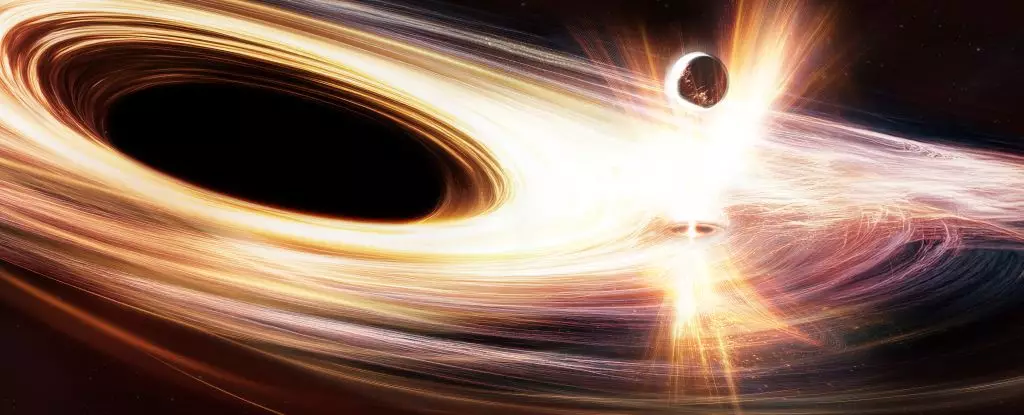Astronomers are often captivated by the wonder and enigma of black holes, but the discovery of a supermassive black hole named Ansky, located 300 million light-years away in the galaxy designated SDSS1335+0728, has thrust our understanding into a maelstrom of challenge and curiosity. Since 2019, researchers have observed Ansky as it transitioned from a state of dormancy to an unprecedented flare of activity. For black holes, such behavior is not entirely unusual; however, Ansky’s fierce outbursts challenge the norms of astrophysical theory, reigniting debates about the fundamental aspects of black hole behavior and the role they play in cosmic evolution.
The Unexpected Eruptions
The intensity of Ansky’s outbursts has baffled astrophysicists. Doctor Joheen Chakraborty from MIT noted that the X-ray emissions from Ansky are not only tenfold longer but also significantly brighter compared to standard quasi-periodic eruptions observed in similar astronomical phenomena. Each burst from Ansky is releasing an astonishing hundred times more energy than what has been documented elsewhere, suggesting that this black hole operates outside the boundaries of what we have come to expect from such cosmic giants. With a recurrence period of 4.5 days— the longest cadence recorded to date—Ansky is pushing modern astrophysical models to their breaking point, making it a focal point for researchers looking to understand the physical properties of black holes more deeply.
A New Understanding of Supermassive Black Holes
The typical narrative surrounding black holes positions them as cosmic vacuum cleaners, drawing in everything without discrimination. While this metaphor offers a glimpse into their gravitational prowess, it fails to capture the complexity and variability of their existence and behaviors. The supermassive black hole at the center of our own Milky Way, for example, is much less active and reveals that these behemoths shift between periods of voracious consumption and relative quiescence. This duality is fundamental to the evolution of galaxies, as active black holes are pivotal in shaping their environments, influencing star formation, and determining the chemical evolution of their host galaxies.
Black holes are not only critical cosmic entities in their own right but also serve as pivotal markers of galactic history. The presence of an active supermassive black hole often correlates with an evolutionary flourishing within the galaxy, as energetic bursts can enhance star formation rates and alter chemical distributions across vast regions of space.
The Fascinating Case of Ansky’s Awakening
Unlike its more subdued counterparts, Ansky has provided a dynamic spectacle of activity that is easily observable. “Ansky has become the first supermassive black hole observed reactivating in real time,” stated astronomer Lorena Hernández-García, who played a leading role in monitoring this phenomenon. The reception of the first quasi-periodic eruption from Ansky in 2019 was groundbreaking; however, the handful of eruptions recorded subsequently allude to an underlying story yet to be told. The excitement lies not just in the emissions but in the deeper questions they raise about what mechanisms drive these flare-ups. Are they a product of external celestial objects like stars spiraling into the black hole, or is there a more intrinsic process at work?
This mystery invites a reevaluation of existing models, compelling scientists to explore uncharted territory in black hole analysis. The brightness of Ansky’s eruptions, which spans a variety of wavelengths from infrared to X-rays, prompts inquiries into their causative factors. The duration and intensity diverge significantly from established trajectories, indicating that our understanding of black hole dynamics may need radical revisions.
Future Implications and Research Directions
The revelations surrounding Ansky may have implications beyond our immediate astronomical understanding. Erwan Quintin of the European Space Agency suggests that the characteristics of these eruptions could be associated with gravitational wave phenomena that future missions, like ESA’s LISA (Laser Interferometer Space Antenna), may be able to detect. Such advancements would allow for a symbiotic relationship between theories and observational capabilities, potentially unlocking knowledge that bridges theories of relativity, quantum mechanics, and cosmic evolution.
In essence, Ansky’s dramatic behavior represents a convergence of curiosity and the opportunity for significant breakthroughs in our comprehension of the universe. The stark contrasts in its jet emissions are a clarion call, thrusting past understandings into the spotlight and demanding that we adapt and rethink our theories. As research progresses, the relationships between black holes and their galaxies will continue to illuminate the cosmic symphony, ultimately enriching our understanding of the universe and our place within it.

